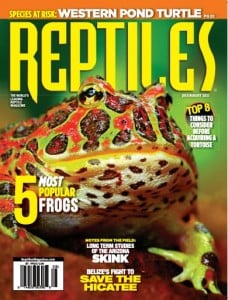Western Fox Snake
U.S., from South Dakota east to Wisconsin, and south through Indiana and Illinois
A basic setup for a hatchling western fox snake can consist of a 10-gallon terrarium, with aspen shavings, reptile bark or reptile carpet as a substrate (they do like to burrow, so I prefer to provide mine with aspen bedding).
Attach an under-tank heating pad at one end of the enclosure, and adjust it to provide a hot spot of 90 degrees Fahrenheit. Inside, place a hide very close to the hot spot — kind of half in and half out of it. This arrangement results in not only a nice thermal gradient for inside the enclosure, but also a “mini gradient” inside the hide. Place another hide at the other, cooler end of the enclosure, as well as a water bowl.
As with all snakes, a secure top is a must. If the terrarium comes with a sliding top or sliding front doors, make sure these are always securely closed and, in most cases locked, so your snake doesn’t take a walkabout (crawlabout?) without your permission.
A fluorescent light on top of the screen top adds a nice touch so you can see the snake and provide it a 12 hours on/off day/night cycle. As for decorations, be creative. Branches, rocks (be sure they are secure and cannot fall over, including if your snake burrows beneath them), cork bark rounds — these all make nice decorations and things for the snake to explore. Plastic plants have become so realistic looking, and these, too, are great additions to spruce up a fox snake enclosure. Just be sure that whatever you use is easy to remove, clean, and sometimes replace.
The setup can be the same for older and larger snakes, but on a larger scale. A 40-gallon terrarium will house up to two fox snakes. If housing two, double the number of hiding places, and provide an additional water bowl. Use a properly sized heat pad to establish the hot spot and thermal gradient (they come in various sizes based on the size of the enclosure with which they’ll be used).
You can add more decorations to the larger enclosure. Remember, the more you put in the terrarium, the more space you are providing for the snakes to crawl into, explore and/or hide.
Feed western fox snakes pre-killed mice. I recommend feeding them in another container outside of the enclosure they live in. Something as simple as a paper lunch bag works well for hatchlings and juveniles (be sure it’s secure, and that they can’t get out), and a plastic Rubbermaid or Sterlite container with a secure top works great for subadult and adult snakes.
Western fox snakes are not always easy to find, but they are becoming more common as captive breeding increases, and can sometimes be found in specialty reptile stores, online, and also at reptile shows.
I’m not aware of any morphs. Eastern fox snakes (Pantherophis gloydi) are protected and almost impossible to find, even as captive bred. Only buy captive-bred fox snakes!
The name “fox snake” is due to the fact that when they feel threatened, these snakes will emit an odor that is said to resemble the smell of a red fox fart (musk).

